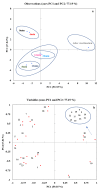Characterization of Volatile Profiles and Marker Substances by HS-SPME/GC-MS during the Concentration of Coconut Jam
- PMID: 32192035
- PMCID: PMC7142570
- DOI: 10.3390/foods9030347
Characterization of Volatile Profiles and Marker Substances by HS-SPME/GC-MS during the Concentration of Coconut Jam
Abstract
Characteristic aromas are usually key labels for food products. In this study, the volatile profiles and marker substances of coconut jam during concentration were characterized via sensory evaluation combined with headspace solid phase microextraction-gas chromatography-tandem mass spectrometry (HSPME/GC-MS). A total of 33 aroma compounds were detected by HSPME/GC-MS. Principal component analysis revealed the concentration process of coconut jam can be divided into three stages. In the first stage, esters and alcohols were the two main contributors to the aroma of the coconut jam. Next, a caramel smell was gradually formed during the second stage, which was mainly derived from aldehydes, ketones and alcohols. The concentration of aldehydes increased gradually at this stage, which may be the result of a combination of the Maillard reaction and the caramelization reaction. In the final sterilization stage, the 'odor intensity' of caramel reached the maximum level and a variety of aroma compounds were produced, thereby forming a unique flavor for the coconut jam. Finally, furfural fit a logistic model with a regression coefficient (r2) of 0.97034. Therefore, furfural can be used as a marker substance for monitoring the concentration of coconut jam.
Keywords: HS-SPME/GC-MS; PCA; coconut jam; marker substances; volatile profiles.
Conflict of interest statement
The authors declare that they have no conflict of interest.
Figures






Similar articles
-
Advantages of UHT in retaining coconut milk aroma and insights into thermal changes of aroma compounds.Food Res Int. 2024 Oct;194:114937. doi: 10.1016/j.foodres.2024.114937. Epub 2024 Aug 17. Food Res Int. 2024. PMID: 39232549
-
Differences of characteristic aroma compounds in Rougui tea leaves with different roasting temperatures analyzed by switchable GC-O-MS and GC × GC-O-MS and sensory evaluation.Food Funct. 2021 Jun 8;12(11):4797-4807. doi: 10.1039/d1fo00165e. Food Funct. 2021. PMID: 33861271
-
Evaluation of aroma characteristics in grass carp mince as affected by different washing processes using an E-nose, HS-SPME-GC-MS, HS-GC-IMS, and sensory analysis.Food Res Int. 2022 Aug;158:111584. doi: 10.1016/j.foodres.2022.111584. Epub 2022 Jun 27. Food Res Int. 2022. PMID: 35840265
-
Variations of volatile flavour compounds in finger citron (Citrus medica L. var. sarcodactylis) pickling process revealed by E-nose, HS-SPME-GC-MS and HS-GC-IMS.Food Res Int. 2020 Dec;138(Pt A):109717. doi: 10.1016/j.foodres.2020.109717. Epub 2020 Sep 24. Food Res Int. 2020. PMID: 33292962
-
Aroma Clouds of Foods: A Step Forward to Unveil Food Aroma Complexity Using GC × GC.Front Chem. 2022 Mar 1;10:820749. doi: 10.3389/fchem.2022.820749. eCollection 2022. Front Chem. 2022. PMID: 35300387 Free PMC article. Review.
Cited by
-
Co-fermentation of Lactiplantibacillus plantarum and Saccharomyces cerevisiae enhances the flavor characteristic of mature coconut water: Insights from volatile and non-volatile profiles.Food Chem X. 2025 Jul 24;29:102832. doi: 10.1016/j.fochx.2025.102832. eCollection 2025 Jul. Food Chem X. 2025. PMID: 40756332 Free PMC article.
-
Bioactive and Physicochemical Characteristics of Natural Food: Palmyra Palm (Borassus flabellifer Linn.) Syrup.Biology (Basel). 2021 Oct 11;10(10):1028. doi: 10.3390/biology10101028. Biology (Basel). 2021. PMID: 34681127 Free PMC article.
-
Sugars Replacement as a Strategy to Control the Formation of α-Dicarbonyl and Furanic Compounds during Cookie Processing.Foods. 2021 Sep 5;10(9):2101. doi: 10.3390/foods10092101. Foods. 2021. PMID: 34574211 Free PMC article.
-
Flavor and Aroma Analysis as a Tool for Quality Control of Foods.Foods. 2021 Jan 22;10(2):224. doi: 10.3390/foods10020224. Foods. 2021. PMID: 33499019 Free PMC article.
-
Isolation and Identification of β-Glucosidases-Producing Non-Saccharomyces Yeast Strains and Its Influence on the Aroma of Fermented Mango Juice.Molecules. 2023 Aug 5;28(15):5890. doi: 10.3390/molecules28155890. Molecules. 2023. PMID: 37570860 Free PMC article.
References
-
- Reynolds S., Fussell R., de Kok A., Anastassiades M. Guidance document on analytical quality control and validation procedures for pesticide residues analysis in food and feed. European Commission; Brussels, Belgium: 2013. pp. 2–44.
-
- Wang W., Chen H., Ke D., Chen W., Zhong Q., Chen W., Yun Y.H. Effect of sterilization and storage on volatile compounds, sensory properties and physicochemical properties of coconut milk. Microchem. J. 2019;153:104532. doi: 10.1016/j.microc.2019.104532. - DOI
-
- Chambal B., Bergenståhl B., Dejmek P. Coconut press cake alkaline extract—Protein solubility and emulsification properties. Food Nutr. Sci. 2013;4:29–37. doi: 10.4236/fns.2013.49A2005. - DOI
-
- Basu S., Shivhare U.S. Rheological, textural, micro-structural and sensory properties of mango jam. J. Food Eng. 2010;100:357–365. doi: 10.1016/j.jfoodeng.2010.04.022. - DOI
LinkOut - more resources
Full Text Sources
Miscellaneous

